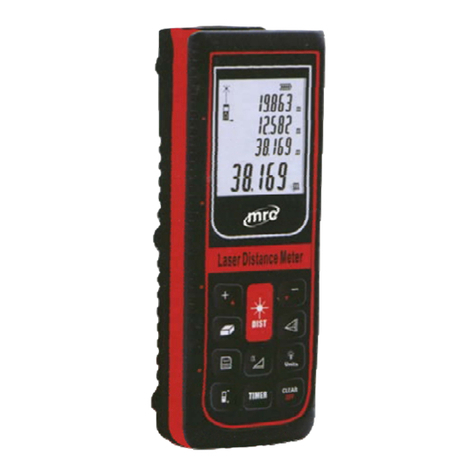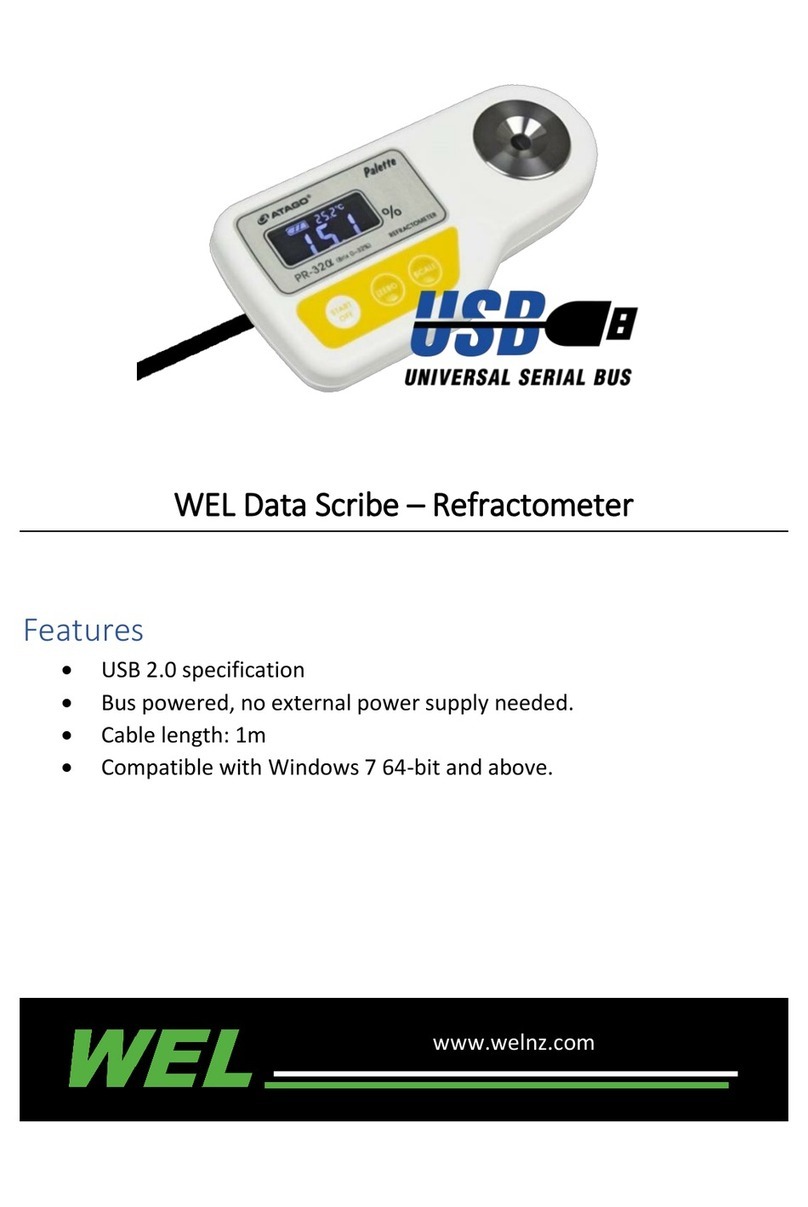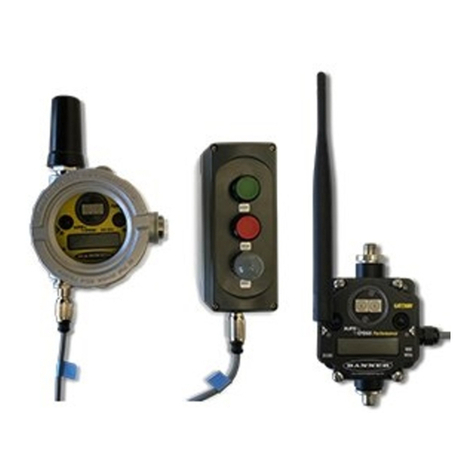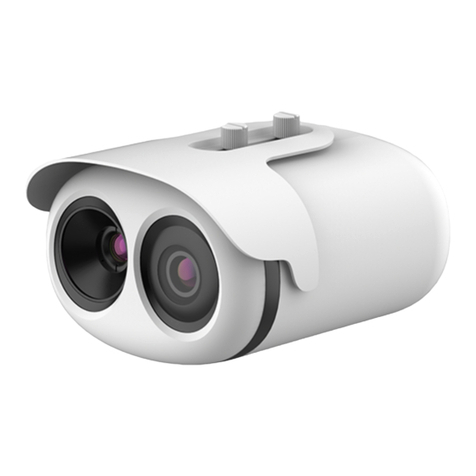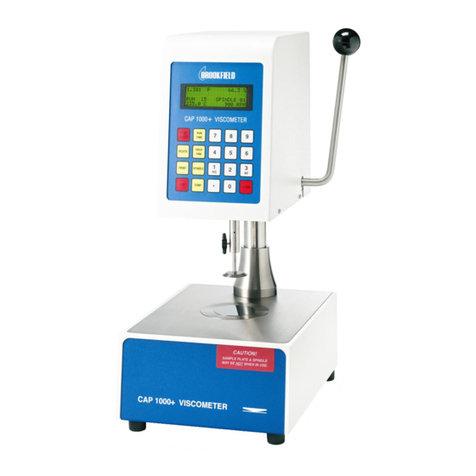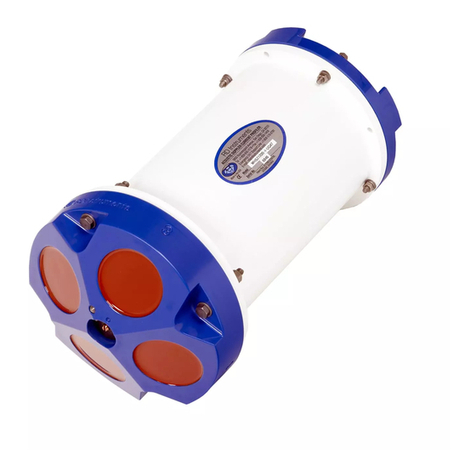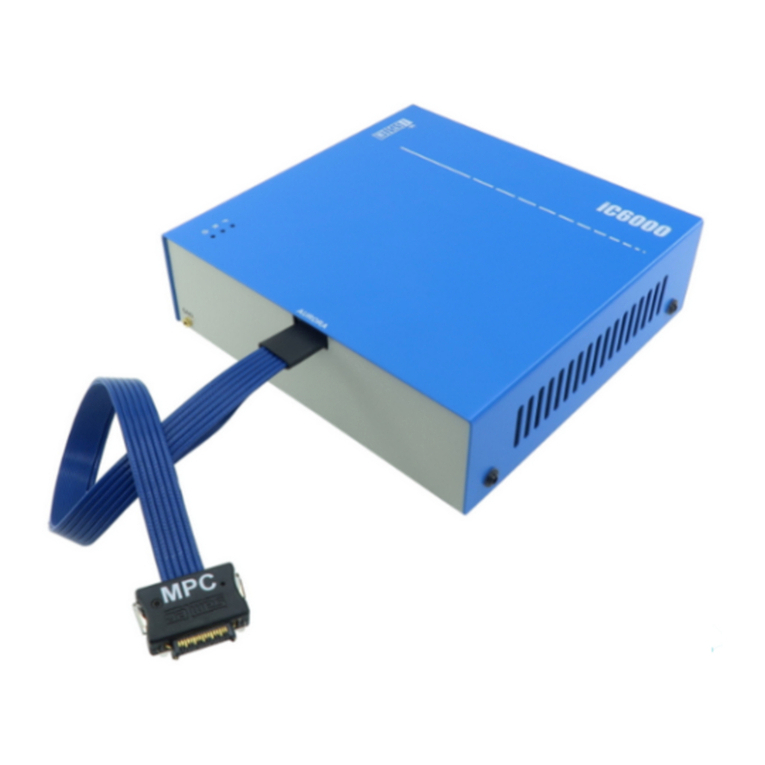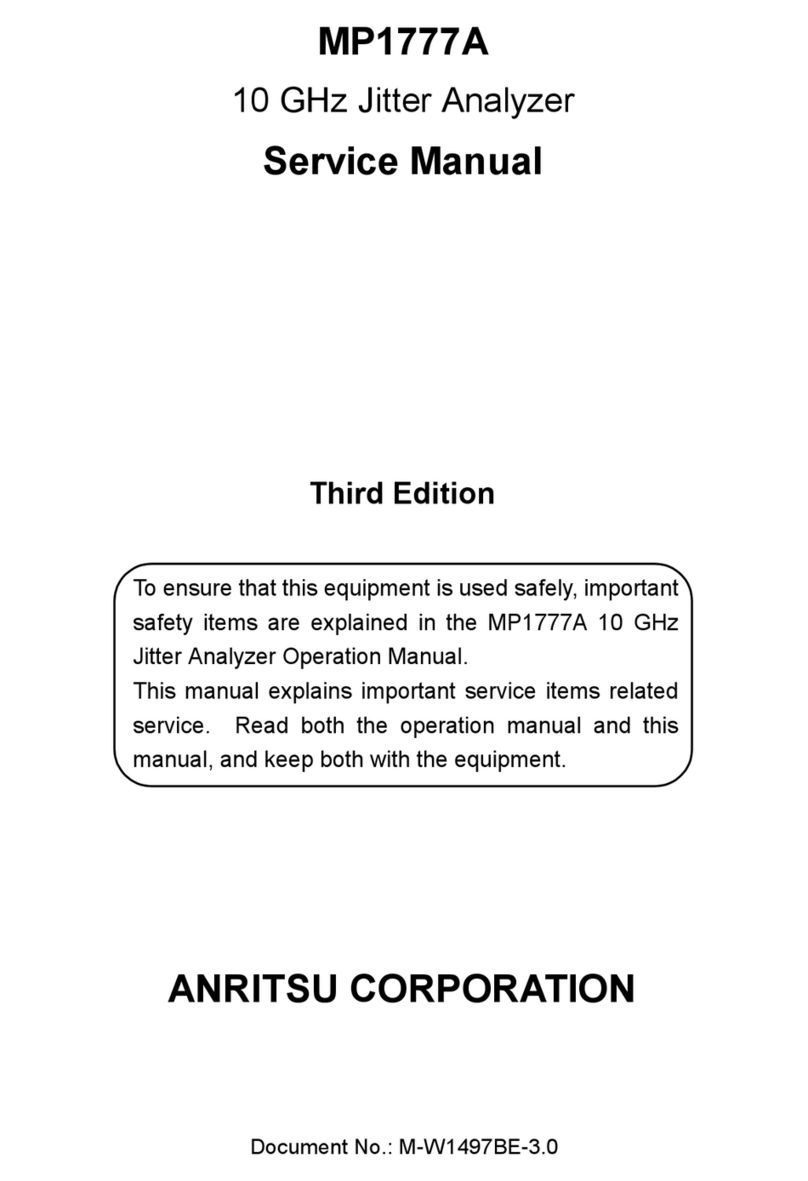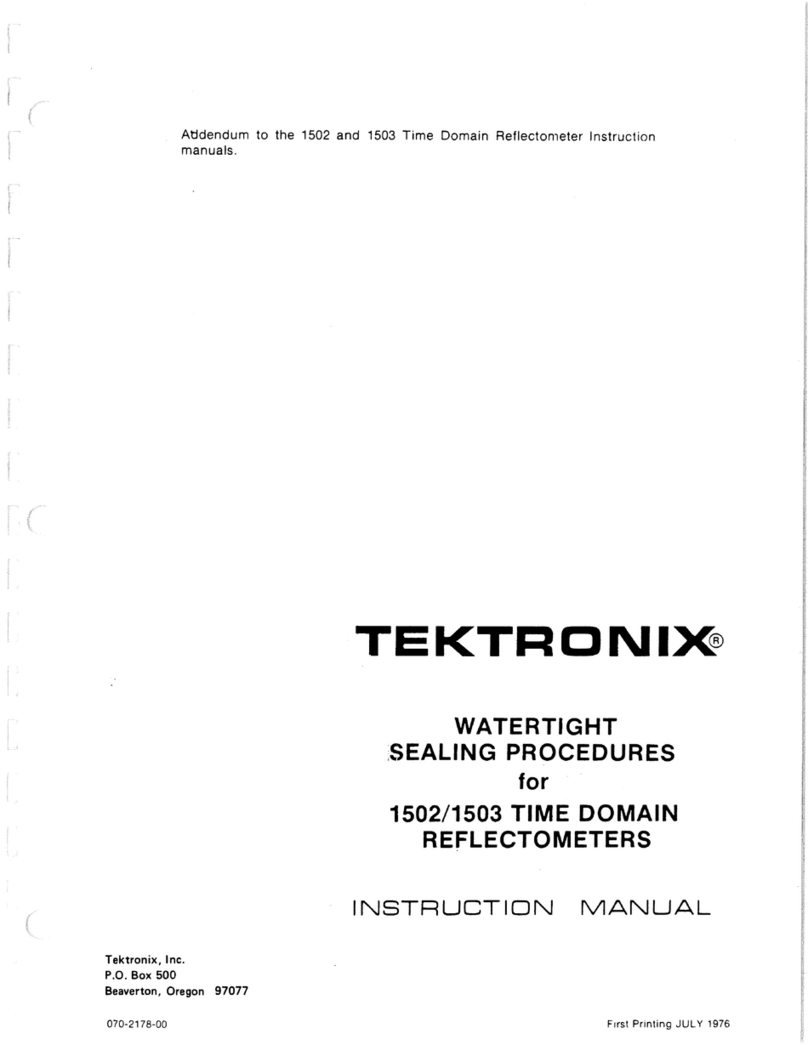SensorLink 8-182 User manual

SensorLink
Operators Manual
Radio Ohmstik
Radio Linked
Micro Ohmmeter

Model 8-182
Radio Ohmstik Transmitter
Model 8-184 not pictured
Model 8-180
Radio Ohmstik Display Unit
Model 6-182
Radio Ohmstik Kit
and Accessories

OPERATORS MANUAL
Radio Ohmstik
Radio Linked Live-Line Micro Ohmmeter
Table of Contents Page
Theory of Operation 3
Safety Information 3
FCC & Industry Canada Statements 3
Specifications 4
Software Requirements & Installation 5
USB Port Permission 5
Communicating the Measurement 5
Operating Instructions 6-7
Taking a Measurement 8
Reviewing the Measurement 9
Powering Off 9
Troubleshooting 10-11
Deterioration Influences 12
Ohmstik Evaluation Method 13-14
Probes & Accessories 15-16
Battery Replacement & Cleaning 17
Warranty 18
Quality Assurance Back Cover
Available Stock Codes:
8-182 50HZ 8-182 60HZ 8-182 EURO
8-180 8-180 EURO 8-184 50HZ
8-184 60HZ 8-184 EURO

Page 3
The Radio Ohmstik Live-Line Micro Ohmmeter measures the micro-ohm resistance of
conductors, connectors, splices and switching devices positioned directly on energized,
high voltage lines. The Radio Ohmstik calculates resistance by measuring the AC
amperage in the line and the voltage drop due to the resistance of the line segment
under test. Using the AC current in the line insures that realistic current distributions
through the connection are being measured. The instrument is pressed against the
splice or connector in such a manner that the connection under test is between the
two electrodes.
The Radio Ohmstik sends its status and measurements to both the Remote Display
and the Radio Ohmstik Software on the user's laptop. At the same time, the GPS
device sends location data to the Software. When a valid measurement is received,
the software writes the data to a comma separated (CSV) file. This allows the user to
map the location of the connector as well as its condition.
Theory of Operation
The probes on the Radio Ohmstik measure voltage drop and
are intended to measure the micro voltage drop from the
same phase.
Connecting the probes in a phase to phase, phase to ground,
or any application where the voltage potential between
the probes is more than 2.5 volts will cause damage to the
instrument and create a system fault.
Do not touch or engage the air gap of adjacent phases or
ground connections with the probes.
Safety Information:
United States of America and Canada
Contains FCC ID: OUR-XBEEPRO
Contains Model XBee-PRO Radio, IC: 4214A-XBEEPRO
The/XBee-PRO® RF Module has been certified by the FCC for use with other products without
any further certification (as per FCC section 2.1091). Modifications not expressly approved by
Digi could void the user's authority to operate the equipment.
This equipment has been tested and found to comply with the limits for a Class B digital
device, pursuant to Part 15 of the FCC Rules. These limits are designed to provide
reasonable protection against harmful interference in a residential installation. This
equipment generates, uses and can radiate radio frequency energy and, if not installed
and used in accordance with the instructions, may cause harmful interference to radio
communications. However, there is no guarantee that interference will not occur in a
particular installation.
If this equipment does cause harmful interference to radio or television reception, which can be
determined by turning the equipment off and on, the user is encouraged to try to correct the
interference by one or more of the following measures: Re-orient or relocate the receiving antenna,
Increase the separation between the equipment and receiver, Connect equipment and receiver
to outlets on different circuits, or Consult the dealer or an experienced radio/TV technician for
help.
FCC & Industry Canada statements

Specifications
Page 4
Model Number & Type 8-182 8-184
Type Standard Wide Jaw
Sensor Opening 2.5 in, 6.35 cm 3.86 in, 9.8 cm
Weight 2.3 lbs, 1.05 kg 4.0 lbs, 1.81 kg
Measurements
Amps 1-1400 A
Microohms 5-2500 µ
Accuracy
Amps ±1% 1 A
Microhms Absolute ±2% 2
Microhms Repeatability ±1% 2
Accuracy is diminished if the current is less than 15 amps 0-35kV and when current is less than 50 A while on 36-500kV
Range of Operation
Voltage Rated 500kV
Resolution
Amps 1.9-99 A 0.1 A
Amps 100-1400 A 1.0 A
Microhms 0-999 µ1 µ
Frequency Actual frequency indicated on the unit
50Hz Calibrated 47 to 53Hz
60Hz Calibrated 57 to 63Hz
Radio
Frequency ISM 2.4 GHz
Power 63 mW, 10 mW in Europe & Japan
Range 150', (46 meters) Line of Sight, 120' (36.5 meters) in Europe & Japan
Mechanical
Battery 9 Volt Alkaline, 1 each per unit
Battery Life 6-8 Hours at 68°F or 20°C, 3-4 Hours at 32°F or 0°C
Detachable Probes Fused Probe or Adjustable Probe
Ambient Temperature -4 to +140° F, -20 to +60° C
Display Graphics LCD
Software Requirements Radio Ohmstik Software
System Requirements Windows XP, Vista, Windows 7, Windows 8
Hardware Requirements Minimum of two USB ports
EEC Standards Successfully passed international test standards indicated by CE

Radio Ohmstik Software
The Radio Ohmstik Software will display information on the Display Unit and will
also write the collected data to a comma separated value (CSV) file in software.
The following data is collected: Amps, Micro-Ohms, Date, Time, Comments,
Latitude, and Longitude (with the GPS USB plugged into the laptop).
System Requirements
The Radio Ohmstik software installs on all computers running Windows XP, Vista,
Windows 7 & 8. The GPS and Radio Ohmstik Software each require a USB port.
Software Installation
1. Place the Radio Ohmstik Software Install CD in your computer’s CD Drive
2. The Installation Wizard will automatically load and display on your PC.
**If you need to launch the install manually, go to the Start Menu, select RUN
and type :\SETUP.EXE, OR - Click on browse, open the drive that your CD is
located, and double click on file titled SETUP
3. You must agree to the licensing agreement to proceed with the download
4. A dialog box will appear to let you know when the download is complete
5. Shortcut paths will automatically load during the install
USB Port Permissions
Computers managed by electric utility organizations often limit the programs that
can be installed. The USB devices in this kit have install programs that run the
first time they are installed. The user may have rights to install programs but may
not be aware that the USB ports are locked. If the USB devices are not discovered
automatically, their drivers will need to be installed manually. The USB Radio
Drivers are loaded on the program CD. The USB GPS Driver came on a CD with
the USB GPS device. Please contact your network administrator for permission and
instructions to complete the install If the drivers need to be installed manually.
Page 5
Communicating the Measurement
The user is able to view the measuremet sets on both a Display Unit and on a laptop
running Radio Ohmstik software. These communications may be used singly, or at
the same time.
Communicating to the Display Unit: The Display Unit is designed to be attached
to a hot stick, or held by hand. The sensor transmits the live readings to the Display
Unit via radio. This functionality allows the user to easily see readings were taken.
Readings are not saved on the Display unit.
Communicating to the Laptop: With the Radio Ohmstik software loaded, and the
radio adapter plugged in, the Sensor will transmit the data and readings to the lap-
top. The measurement set will automatically be saved as a .csv file for future review.

Page 6
Operating Instructions
Setup Communication with Radio Ohmstik Software
1. Plug the 7-024 USB Radio and the 7-025 USB GPS devices into the laptop's USB
ports. It will take several seconds for the computer to discover the devices
2. Open the Radio Ohmstik Software
3. The program starts by asking the user to select a file name and location to
write the data.
Note: The default File Name is a date and time code for the date
and time the application is opened.
4. Select Save; the Radio Ohmstik Dashboard will load and is ready for
measurments

Page 7
Copyright 2011
SensorLink
F574 8XP 300
Firmware XXX No Signal
Display Software Dashboard
Setup Communication with Display Unit
1. Place the Display Unit on the hot stick with the Velcro strap so the LCD display
is visible while taking measurements
2. Press the function button on the Display Unit. The display will run through its
boot screens, ending in No Signal
Setup Radio Ohmstik Sensor
1. Attach the Probe to the back of the Radio Ohmstik.
2. Press the function button on the Radio Ohmstik sensor. The Radio Ohmstik
transmits to both the Display and the Radio Ohmstik Software
3. They both indicate the Radio Ohmstik is ready to take measurements

Page 8
Taking a Measurement:
1. Place the Radio Ohmstik on a conductor as depicted in Figure 3.0. It is essential
you make contact between the conductor and the voltage sensor, which is the
V-shaped plate between the jaws, as well as the voltage probe.
2. Measurement begins as soon as the Ohmstik is in position and is stable
3. While the Radio Ohmstik is taking the measurement, the screens will display:
4. The display screens will show the current in the conductor as well as the Micro-
Ohm resistance of whatever is between the two voltage probe
5. Remove the Ohmstik from the conductor. It holds the reading and displays
it as follows:
6. Remove the Radio Ohmstik from the conductor or splice
7. The measurements are now written to the Radio Ohmstik software
8. The displays will continue to show readings until the Radio Ohmstik is placed on
a new current carrying conductor or until it powers down
Figure 3.0

Page 9
Power Off the Radio Ohmstik
Press and hold the Function Button on the Display Unit until the LCD goes blank
or Press and hold the Function Button on the Radio Ohmstik until the LED goes off.
Either of these actions will power off itself and the accompanied device. The Radio
Ohmstik will power off by itself if left inactive for 20 minutes.
Reviewing Measurements in Software
1. The Radio Ohmstik software will display the completed measurement and GPS
location on the Dashboard
2. The data will automatically be written to a comma-separated values (CSV) file
when the Radio Ohmstik is removed from the conductor
3. A comment may be added before the reading is taken. Any comment written
will be a part of the record for the next reading
4. To review the data, open the saved CSV file in any spreadsheet or word
processing application
Note: Opening the CSV file while the dashboard is open, will stop the recording
of readings. The number of readings will be recorded on the dashboard
but the readings will not be stored.

Troubleshooting and Error Messages:
“No Contact”
The Radio Ohmstik reads current but not µs:
This indicates that either one of the two voltage sensors is not making contact. Use
the rough edges of the probes to clean the corrosion from the conductor and re-
take the measurement. Make certain that both voltage sensors are making contact.
“Poor Contact”
This means either there is Poor Contact between the two voltage contacts:
Provide five seconds to measure, while the Radio Ohmstik is held stationary with
both voltage probes securely on the line.
“Reading Ohms”
The following message indicates that the current measurement was completed
before the resistance measurement could be completed:
Provide five seconds to measure, while the Radio Ohmstik is held stationary with
both voltage probes securely on the line.
“Unable To Measure”
The Radio Ohmstik uses logic to know when it is on a conductor by looking for a
stable load:
Hold the Radio Ohmstik firmly on the line for at least five seconds. The Ohmstik
samples the line three times every 100 milliseconds. If it cannot find three
consecutive reads that are similar within five seconds it will display “Unable To
Measure”.
Page 10

“Exceeds 1400 Amps”
The Radio Ohmstik limits the maximum current to 1400 Amps;
Exceeds Limits indicates that the current limit has exceeded 1400 Amps.
Page 11

Application: Deterioration Influences
Time is not an “aging factor” for fittings. Deterioration is due to increases in resistance
of the connection. The increased resistance is produced, in part, by peaks of load and
fault current that can heat the interface, even if only temporarily, or for a few cycles
(also in part by oxidation of the interfaces during thermal expansion and cooling, and
by corrosion accelerated by moisture and chemicals in very small quantities that get
in between the strands). Every splice has at least one “uphill” side for water, etc. to
run. The reasons we hear that fewer “dead-ends” fail may be that most of them are
pointed “downhill”.
All of these influences accelerate the deterioration of fittings that are not installed
properly. Cleaning and roughening the conductor was always important in making
a “good fitting”, and with today’s shorter, harder alloy tube fittings, we have found
it critically important, even with the new conductor. Proper dispersion of an inhibitor
will help keep the interfaces from oxidizing. All major manufacturers have frequently
found a missing, or inadequately dispersed, inhibitor when examining failed fittings.
Proper die closure is very important, especially with the newer (last 20 years or so)
alloy tube “single die” type compression fittings. There is generally less conductor
inserted in the fitting than in the older “hex die” type of fitting, so it is less forgiving
of installation error. These consequences of installation lead to incremental increases
in resistance during the service life of the fitting. Resistance measurements of newly
made alloy tube fittings indicate they are more likely to start service at the higher end
of the normal range than the lower end.
Lately, what has been learned about fitting reliability indicates that there will be more
problems with unexpected failures than in the past. This comes at a time when just
the opposite is needed. Fittings need to be replaced on a planned basis, before failure
occurs.
Page 12

Ohmstik Evaluation Method
The Ohmstik Evaluation Method provides definitive and actionable early warnings of
a deteriorating fitting. This method directly measures the resistance of the connection
with an Ohmstik. The resistance is the electrical condition of the splice. If the resistance
is outside the normal range, the connection is deteriorating. A connection with
resistance above the normal range is in a failure process, where the time to failure
depends on how high the resistance is. The appropriate planned actions for ranges of
resistance above normal are shown in Table One. The resistance ratio is calculated by
comparing the resistance of the fitting over the resistance of the conductor.
All fittings or splices consist of two different connectors. All connectors consist
of three resistors in series; the resistance of the conductor, the connector and the
interface between the conductor and the connector (See figure 4.0).
The interface is the only resistor of the three that changes over time. The object of
the Ohmstik Evaluation Method is to measure as little of the conductor & connector
as possible, and all of the section that surrounds the interface.
A good way to make reliability judgments about a connector is to compare the
resistance of the connector assembly to the conductor. This ratio allows you to
compare measurements on connectors of various sizes.
1. In order to establish the baseline, or denominator, for the ratio of the subsequent
measurements, measure the resistance of a portion of the conductor that is equal in
length to the interface portion of the connector.
2. Measure the interface of one of the connectors.
3. Measure the interface of the second connector.
The ratio is calculated by making the conductor measurement as the denominator
and the Connector measurement as the numerator.
Ratio = Connector / Conductor
Figure 1.0
Figure 5.0
Figure 5.1
Figure 5.2
Page 13

Resistance ratio Condition of fitting Action
0.3 to 1.0 Normal Connection Serviceable
New connections are expected to
be in the 0.3 to 0.8 range
None
1.01 to 1.2 Serviceable; poor
Shows deterioration; Overloads
& faults may deteriorate the con-
nection
Re-inspect in one year, or
after next fault
1.21 to 1.5 Serviceable; poor
Serviceable, shows deterioration;
Overloads & faults may deteriorate
the connection
Fault
1.51 to 2.0 Serviceable; very poor
High loads, overloads, or faults may
deteriorate the connection
Schedule replacement in
less than three months
2.01 to 3.0 Bad; deterioration rate is
increasing
High loads, overloads, or faults may
fail the connection; High tensions
from cold weather or wind may
initiate failure under normal loading
Schedule replacement
very soon
> 3.0 Failing
Normal loads, overloads, or faults
may fail the connection; High
tensions from cold weather or wind
are likely to initiate failure under
normal loading
Replace as soon as
possible
The following table shows the suggested action for various ratios based on
maintaining the present load rating.
Note: This information was developed from field measurements, manufacturer
data, lab tests, failure analysis and understanding of deterioration mechanisms.
This guideline may be modified as field & test data accumulates.
Table 1.0: Actions required based on resistance ratios (Rfitting / Rconductor)
Page 14

Standard Probes and Accessories
7-081 XT Standard Fused Probe, for 8-182 Transmitter
7-081 Standard Fused Probe, for 8-184 Transmitter
The probe is designed for use in close proximity to adjacent phases or ground structures
(see Cautions on page one). In the event of making a phase to phase or phase to
ground connection, the Fused Probe will break the connection.
Fused Probe Configuration with Contactor Attachment
Accessory Kit Includes:
(1) Fused Probe (1) Contactor Attachment
(1) 7-084 Wire Brush Contactor (1) Probe Hook
(1) 4" Rod, Straight (1) 4" Rod, Bent
(1) Philips Head Screw (1) Coupling Nut
(4) Lock Washers (6) Hexnuts
Fused Probe Configuration with the Straight Rod and Contactor Attachment
Fused Probe Configuration with the Bent Rod and Curved Rod
Page 15

7-081 ADJ Adjustable Probe Kit
The Adjustable probe is designed for any measurement where the distance to be
measured is less than 12 inches. This probe wil adjust from 4 to 13 inches.
Adjustable Probe Kit includes:
(1) Adjustable Probe (1) 7-084 Wire Brush Contactor
(1) Contactor Attachment (2) Hex Nuts
Page 16
Optional and Replacement Accessories
7-084 Wire Brush Contactor
The Universal Adapter allows the user to adjust the Ohmstik Transmitter at compound
angles. This is a useful adapter when working from the ground on complex apparatus.
7-050 Universal Adaptor

Battery Replacement
The Radio Ohmstik system is powered by two 9V batteries, one in the Radio Ohms-
tik and one in the Display. The expected battery life for both units is 6 to 8 hours at
68°F or 20° C. The expected life declines in colder environments. At 32°F or 0°C it is
reduced 3 to 4 hours.
Note: It is recommended that fresh batteries be installed prior to operation each day
and always replace both batteries.
To replace the battery, remove the four screws on the battery cover at the rear of the
unit. Carefully insert a screwdriver blade in the notch and pry the cover out, being
careful not to damage the cover seal. Pull the battery out of the compartment and
separate the battery from the battery connector. To avoid breaking the battery leads
do not pull on the battery only. Install a fresh battery and reinsert the battery in its
compartment. Do not pinch the wires between the battery and compartment; put
wires in slot above the battery. Reinstall the cover by gently pressing it into place while
pulling out on the edges of the compartment, and reinstall the four cover screws. Take
care to avoid over tightening the screws. Always reuse the screws provided and do not
damage or lose the O-ring seal on each screw.
Cleaning
The Radio Ohmstik can be cleaned by wiping with a small amount of alcohol.
Transporting
There are no special consideration for transporting this device.
Page 17

Sensorlink Corporation Warranty
SensorLink warrants each instrument it manufactures to be free from defects in materials
and workmanship under normal use and service for the period of one year after date
of shipment. Within this period, SensorLink agrees to repair or replace, at SensorLink’s
option, any instrument that fails to perform as specified. This Warranty shall not apply
to any instrument that has been:
1 Repaired, worked on, or altered, including removal of the front panel, by persons
unauthorized by SensorLink in such a manner as to injure, in SensorLink’s sole
judgment, the performance, stability, or reliability of the instrument;
2 Subjected to misuse, negligence, or accident; or
3 Connected, installed, adjusted, or used otherwise than in accordance with the
instructions furnished by SensorLink.
This Warranty is in lieu of any other warranty, expressed or implied. SensorLink reserves
the right to make any changes in the design or construction of its instruments at any
time, without incurring any obligation to make any change whatever in units previously
delivered.
If a failure occurs, contact the manufacturer for a Return Authorization and
instructions for return shipment. This warranty constitutes the full understanding of
the manufacturer and buyer, and no terms, conditions, understanding, or agreement
purporting to modify or vary the terms hereof shall be binding unless hereafter made
in writing and signed by an authorized official of SensorLink Corporation.
Page 18

Quality Assurance Certification
Radio Ohmstik
Transmitter Models 8-182 and 8-184
Display Unit Model 8-180
SensorLink certifies that its calibration measurements are traceable to the National
Institute of Standards and Technology (NIST), to the extent allowed by the Institute's
calibration facility, and to the calibration facilities of other International Standards
Organization members.
This document certifies the following Radio Ohmstik was tested at the Sensorlink High
Voltage Laboratory, Ferndale, WA, USA to the appropriate standard and comply with
the requirements of that standard.
Transmitter; Model Number: _______________________________
Serial Number _______________________________
Display Unit; Model Number: __________________________________
Serial Number _______________________________
I hereby certify that the Radio Ohmstik listed above has passed all tests defined in the
Sensorlink Corporation standard. I also certify that I have reviewed the standard and
test procedure and that they are sufficient in determining compliance with the standard.
Signed____________________________________________________________
Date______________________________________________________________
SensorLinkCorporation
1360 Stonegate Way
Ferndale, WA 98248 USA
phone: 360/595.1000
fax: 360/595.1001
www.sensorlink.com
Form No: SALE-Manual Template OHMSTIK-008 REV: V03
Date: 02/10/2015
Manual Stock Code No: DOPM-818-200
This manual suits for next models
3
Table of contents
Other SensorLink Measuring Instrument manuals
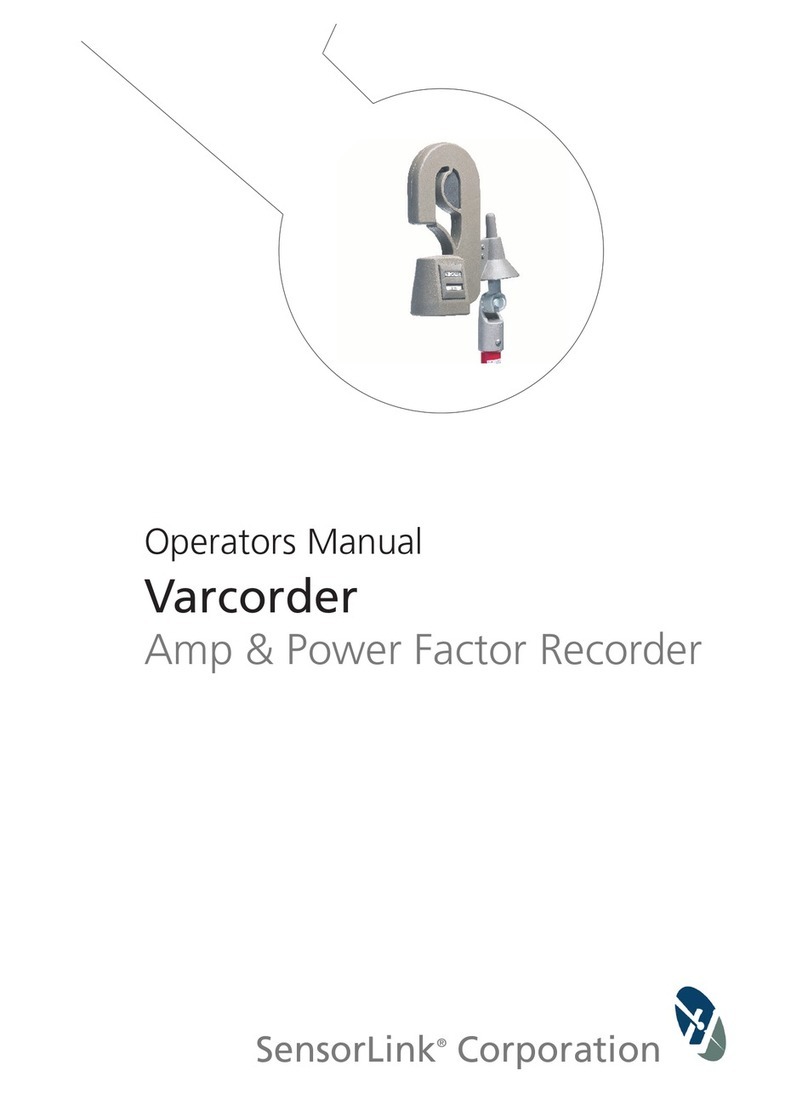
SensorLink
SensorLink Varcorder 910 Series User manual
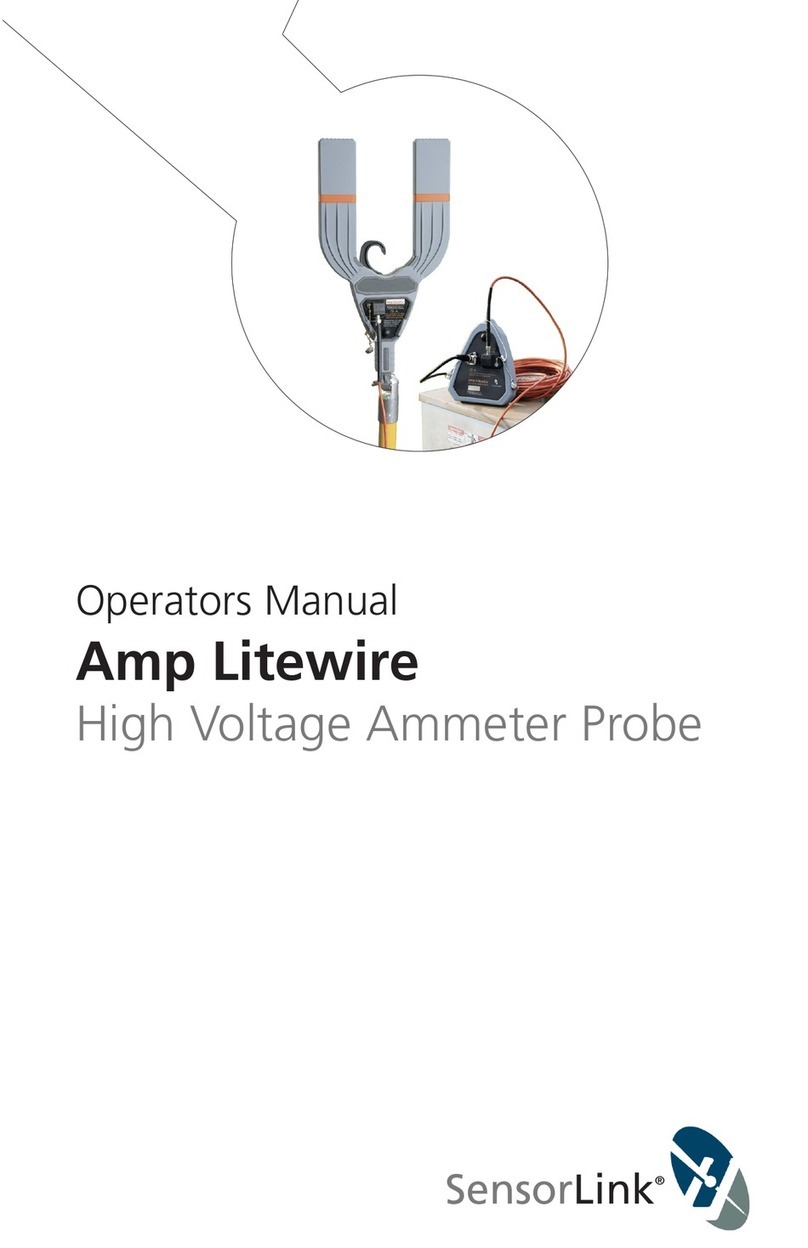
SensorLink
SensorLink 8-117 XT 50HZ User manual
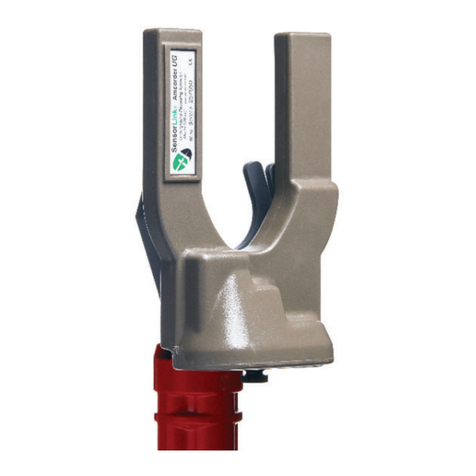
SensorLink
SensorLink Amcorder UG Series User manual
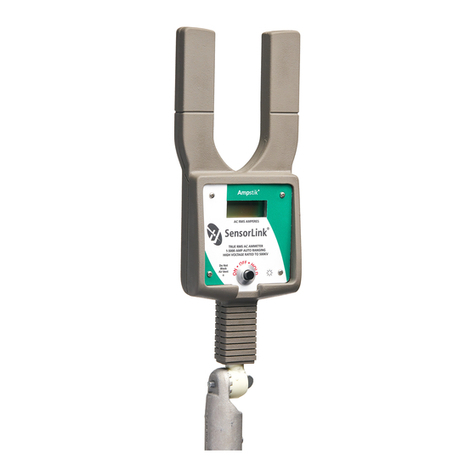
SensorLink
SensorLink Radio Ohmstik User manual
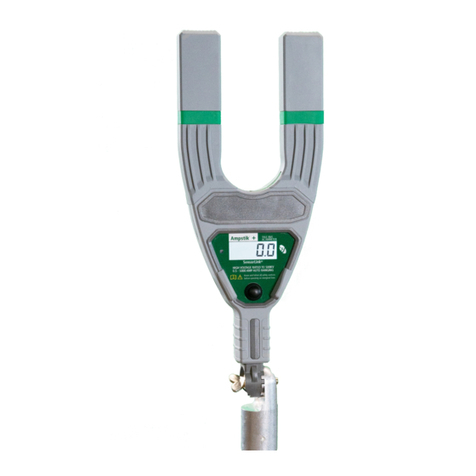
SensorLink
SensorLink Ampstik+ User manual
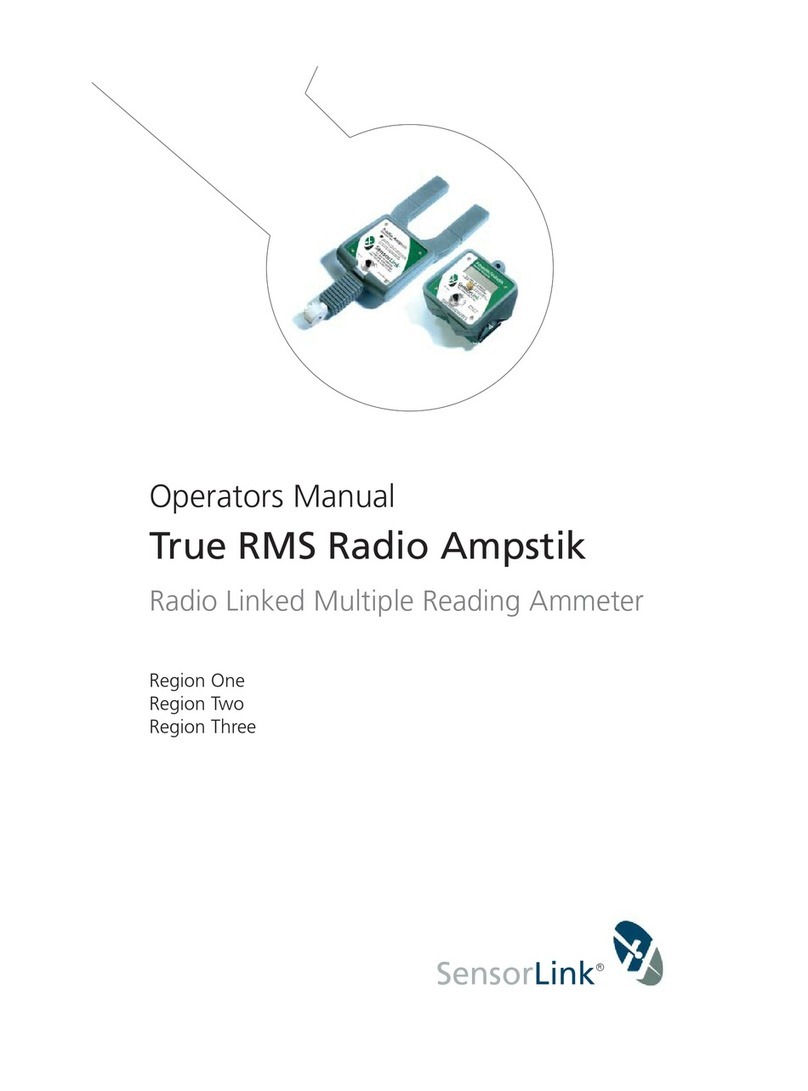
SensorLink
SensorLink 6-120 User manual
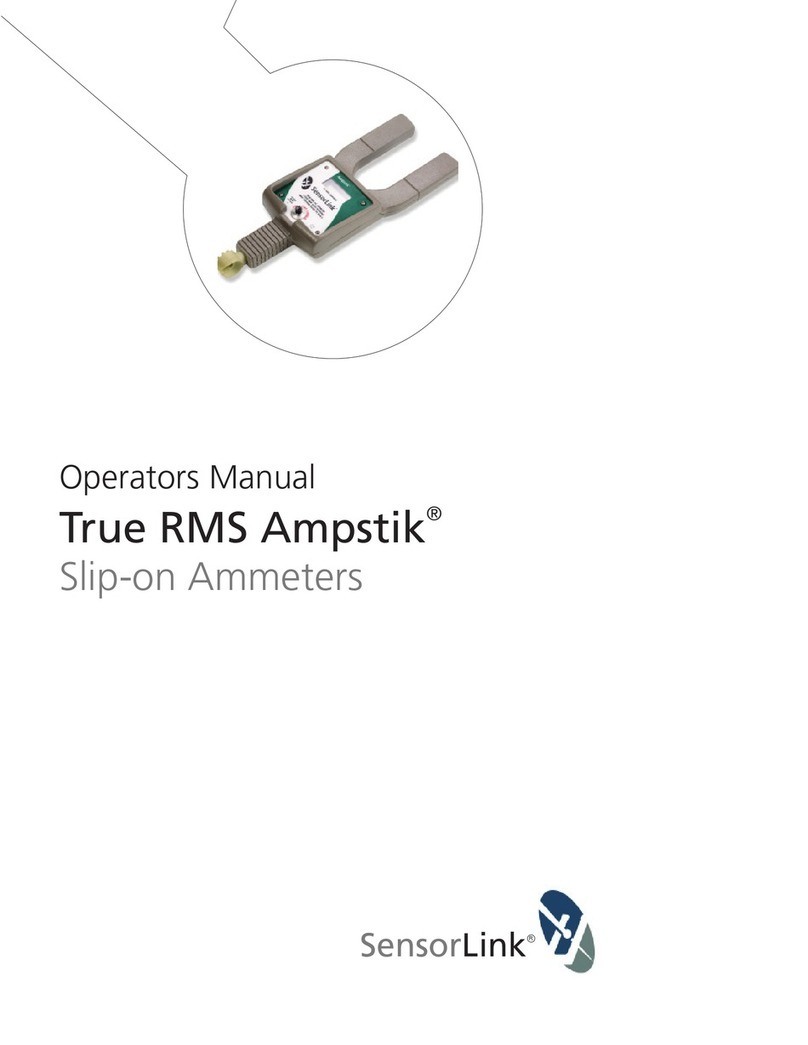
SensorLink
SensorLink True RMS Ampstik 8-020 User manual
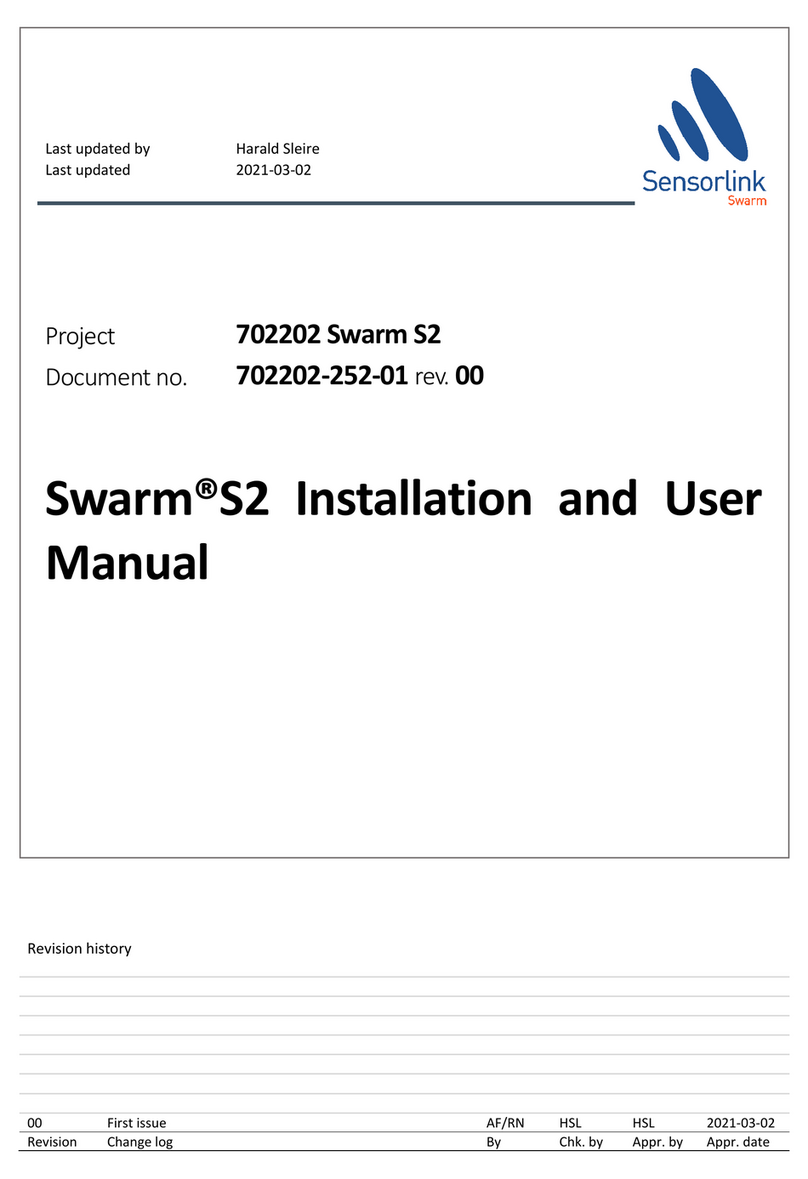
SensorLink
SensorLink Swarm S2 User manual

SensorLink
SensorLink TMS 950 User manual

